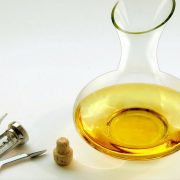A Guide to Drinking Old Wine (Part One – Determining quality)
Determining quality
Old bottles are rare and treasured. Occasionally, they can be found in wine stores or come from friends
that have cellared wines for a long time. Both whites and reds will age well, particularly if they are from
a better producer. Reds with more tannin age longer. I always think of tannin like the fuel of a car. The
more fuel, the longer the car will go, and the car stops once it is out of fuel. Cabernet Sauvignon,
Nebbiolo and Syrah all have a lot of tannin. Most bottles from these varietals will age 10 years easily,
with the best aging 30+ years. Pinot Noir, Merlot, Grenache and Zinfandel have less tannin, and most
will stop improving after 7 years although there are always notable exceptions.
For white wine, higher acidity and flavor concentration is the key. German Riesling, Loire Chenin Blanc
and Chablis are examples that can age 25+ years. White wines that were made in a barrel (as opposed
to an inert vessel) tend to age longer as well. In both reds and whites, I also find that wines with lower
alcohol tend to age better.
However, the main factor in determining the quality in older bottles is the provenance, or how it was
stored. This is often more important than the producer. Heat and sunlight will destroy a wine. Wines
stored in different conditions will show differently, and this is amplified over decades. Bottles stored in
a cellar or basement is best. The colder the temperature, the slower the wine will age and the more
complex it will become. Larger format bottles age at a slower pace as there is less air in the bottle
compared to wine. Conversely, half bottles will age more rapidly.
There are a few visual clues one can use to guess at the wines quality. Old bottles will commonly leak
through the cork, but this does not necessarily mean the wine is bad. As a general rule, the less leakage
the better. The wine’s fill level is the next thing to look at. Young wines have a high-neck fill level, but
over time it lowers to mid and then low-neck. Bottles over 30 years of age move into the shoulder of
the bottle.







